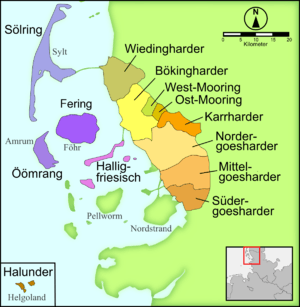Öömrang
| Öömrang | |
|---|---|
| Öömrang | |
 A stone displaying a stanza from "Min Öömrang Lun", a traditional song from Amrum island | |
| Native to | Germany |
| Region | Amrum, Nordfriesland |
Native speakers | ca. 800 (date missing)[citation needed] |
| Language codes | |
| ISO 639-3 | – |
| Linguasphere | 2-ACA-dba[1] |
 North Frisian dialects | |
Öömrang is the dialect of the North Frisian language spoken on the island of Amrum in the German region of North Frisia. Öömrang refers to the Öömrang Frisian name of Amrum, Oomram. Together with the Fering, Söl'ring, and Heligolandic dialects, it forms part of the insular group of North Frisian dialects and it is very similar to Fering. Öömrang is spoken by about one third of Amrum's 2300 people.
Characteristics
- Differentiation between long and short vowels by doubling of the vowel letter (e.g., lun [land, country] and skuul [school])
- Use of numerous diphthongs and one triphthong, "uai" (e.g. spuai [speak the truth])
- Frequent use of umlauts
- Final "w" is pronounced like a short "u" (e.g. leew [dear, sweet])
- The "r" is rolled (as in Italian)
Personal and family names
Personal names on Amrum are still today greatly influenced by a Frisian element. Notably, hypocorisms and names with two elements are common. Early borrowings were made from the Danish language and the Christianisation of the North Frisians around 1000 A.D. brought a modest influence of Christian and biblical names. In the Age of Sail, Dutch and West Frisian forms became popular.[2]
Family names were usually patronymic, i. e. they were individually created as genitives from the father's given name. Contrary to the Scandinavian Petersen or Petersson, meaning "Peter's son", an Öömrang name like Peters means "of Peter". This practice was eventually prohibited by the Danish Crown in 1828.[2]
References
| ||||||||||||||||||||||||||||||